Last year ended and the new one began with indulgences –and there were far too many of them –Austrian smoked ham; prawns big enough to pass for little lobsters in a pool of butter spiced with Creole seasoning carried back from New Orleans; baked Brie; a lot of strong Stilton and a Christmas cake from Mumbai so heavy with fruit and alcohol, that it was an effort to lift each weighty slice. Not to mention all the excellent wines and champagnes. After all the excess and the frenzied activity, I’m looking forward to a quieter, slower time, to some unpretentious, refreshing flavours. Maybe a little time to dream, catch up with all that went into the past year, and plan for this one. 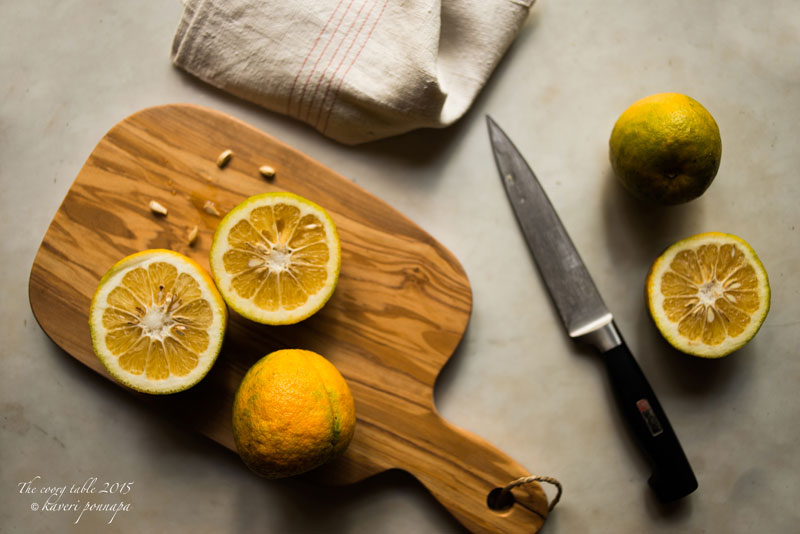
One of the quiet spots I loved best in large, old, tea and coffee plantation homes was the breakfast table. It was usually situated in a sunny corner of the main verandah that ran along the front of the house, or sometimes all around it. It was a table for two, at best four, and could be moved easily to catch the morning sun. This is where the planter and his wife ate their breakfast, looking out, invariably, onto a garden full of English flowers and often, a view of the hills.
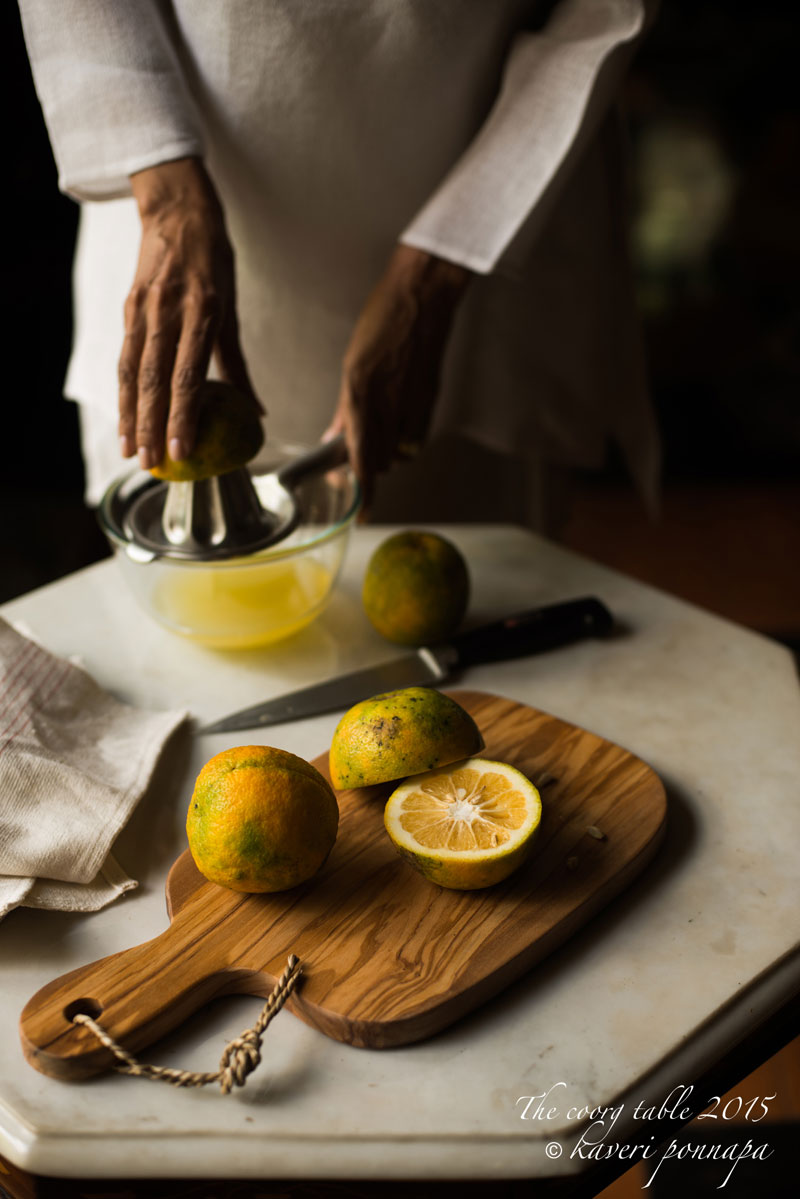 There was toast, a selection of jams, preserves and cereals, fruit juice, baked beans and if the supplies had held out, sausages. With tea and coffee, of course. The china was impossibly delicate and pretty, and always English. A silver toast rack, tea service and a small hand-bell that could be rung to summon the staff completed the scene. The tradition lasted well into the 20th century, and still lingers here and there. It was simplicity itself, but very charming in an old-fashioned way and the setting made everything on the table taste absolutely divine. It was the perfect place to while away the better part of the morning, your feet in the sun, lunchtime still far away, a magazine or newspaper to browse through.
There was toast, a selection of jams, preserves and cereals, fruit juice, baked beans and if the supplies had held out, sausages. With tea and coffee, of course. The china was impossibly delicate and pretty, and always English. A silver toast rack, tea service and a small hand-bell that could be rung to summon the staff completed the scene. The tradition lasted well into the 20th century, and still lingers here and there. It was simplicity itself, but very charming in an old-fashioned way and the setting made everything on the table taste absolutely divine. It was the perfect place to while away the better part of the morning, your feet in the sun, lunchtime still far away, a magazine or newspaper to browse through. 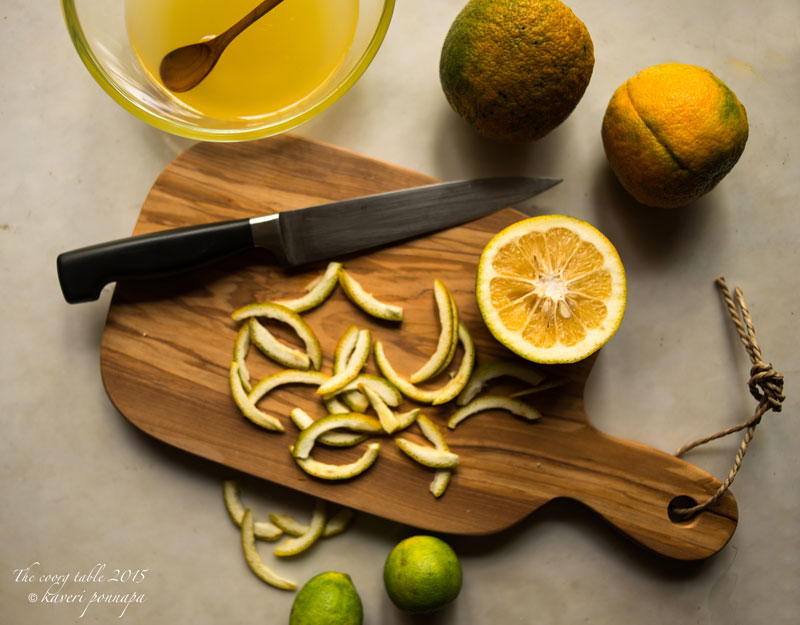
The British started coffee plantations in Coorg, and brought a new style of living and dining with them, which left its imprint on the place and people, a style they adapted to suit their own traditions. (read more about this unique way of life at Plantation Style).
Exquisite handmade lace and embroidered table linens made their way up from Convents, and a supply of jam, jellies and preserves appeared at the table, all home made from seasonal fruit, all part of this legacy. These edible treats were invariably stored in glass jars recycled so many times that they often lasted a generation or two, and travelled to and fro between distant locations with members of a family. 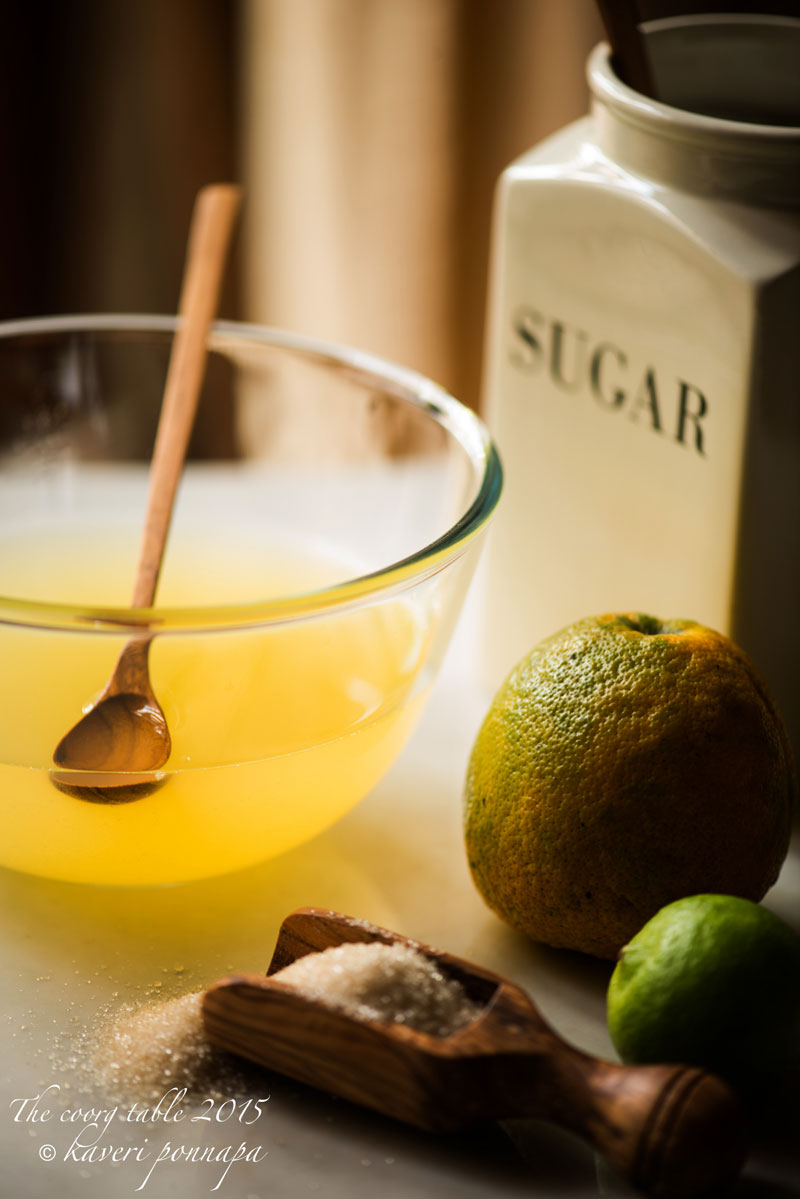 Every time you returned for the holidays, a few familiar bottles, filled with something freshly made that held a promise of delight were lined up on shelves, and would greet you like old friends. Empty bottles of Horlicks, the malted milk drink were a very popular choice, or bottles of Bournvita, and Kissan Mixed Fruit jam left over from school holidays. They were all washed carefully, soaked to remove the labels, sun-dried and then pressed into service. There was an elaborate barter system in re-used bottles between women that I never really understood, but when you received a bottle of jam, you were definitely expected to return the empty jar to the jam-maker. People who were otherwise quite reserved and just a bit snooty always surprised me by asking their friends and relatives, quite unhesitatingly, for empty bottles!
Every time you returned for the holidays, a few familiar bottles, filled with something freshly made that held a promise of delight were lined up on shelves, and would greet you like old friends. Empty bottles of Horlicks, the malted milk drink were a very popular choice, or bottles of Bournvita, and Kissan Mixed Fruit jam left over from school holidays. They were all washed carefully, soaked to remove the labels, sun-dried and then pressed into service. There was an elaborate barter system in re-used bottles between women that I never really understood, but when you received a bottle of jam, you were definitely expected to return the empty jar to the jam-maker. People who were otherwise quite reserved and just a bit snooty always surprised me by asking their friends and relatives, quite unhesitatingly, for empty bottles! 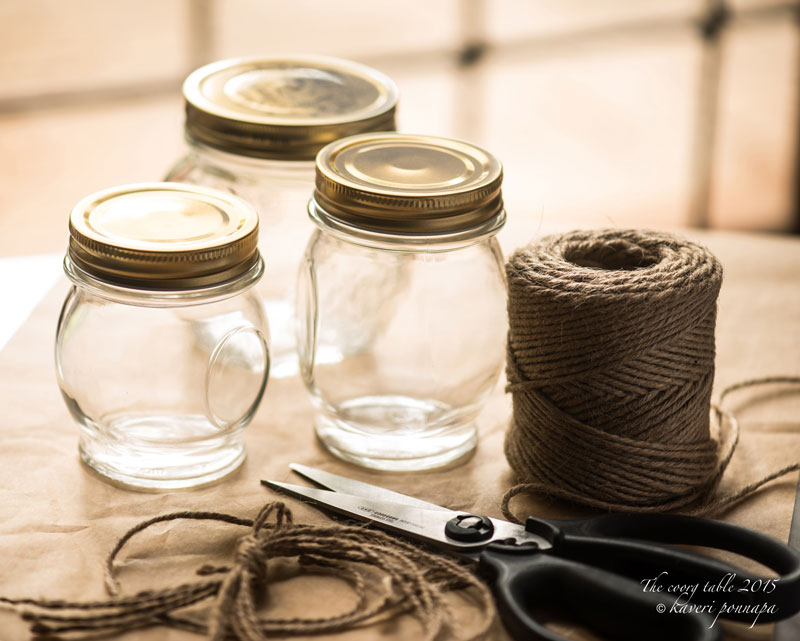 In Coorg, women can turn almost any fruit into something absolutely delicious that goes into a jam jar, or a wine bottle: bananas, papayas, guavas, bitter oranges and much more. My mother-in-law was famous for the extraordinarily good bitter orange marmalade she made from the Coorg kaipuli (Citrus aurantium). She would take the kaipuli, with its fierce, rough skin, its colour ranging from a glowing sunset orange to lemon, and turn its wild bitterness into a beautiful, translucent, trembling mass in which the shreds of rind hung suspended, immobile, the whole thing like some beautiful and distant solar explosion. She perfected the art of making marmalade, and combined with the unique flavour of bitter oranges grown in Coorg soil, the results were so good that I became a marmalade snob. Turning up my nose at Frank Cooper’s, Roses and Wilkin & Sons, it was this homemade version that I preferred over all others, carrying bottles back with me to England, a small gesture of reverse food colonialism.
In Coorg, women can turn almost any fruit into something absolutely delicious that goes into a jam jar, or a wine bottle: bananas, papayas, guavas, bitter oranges and much more. My mother-in-law was famous for the extraordinarily good bitter orange marmalade she made from the Coorg kaipuli (Citrus aurantium). She would take the kaipuli, with its fierce, rough skin, its colour ranging from a glowing sunset orange to lemon, and turn its wild bitterness into a beautiful, translucent, trembling mass in which the shreds of rind hung suspended, immobile, the whole thing like some beautiful and distant solar explosion. She perfected the art of making marmalade, and combined with the unique flavour of bitter oranges grown in Coorg soil, the results were so good that I became a marmalade snob. Turning up my nose at Frank Cooper’s, Roses and Wilkin & Sons, it was this homemade version that I preferred over all others, carrying bottles back with me to England, a small gesture of reverse food colonialism. 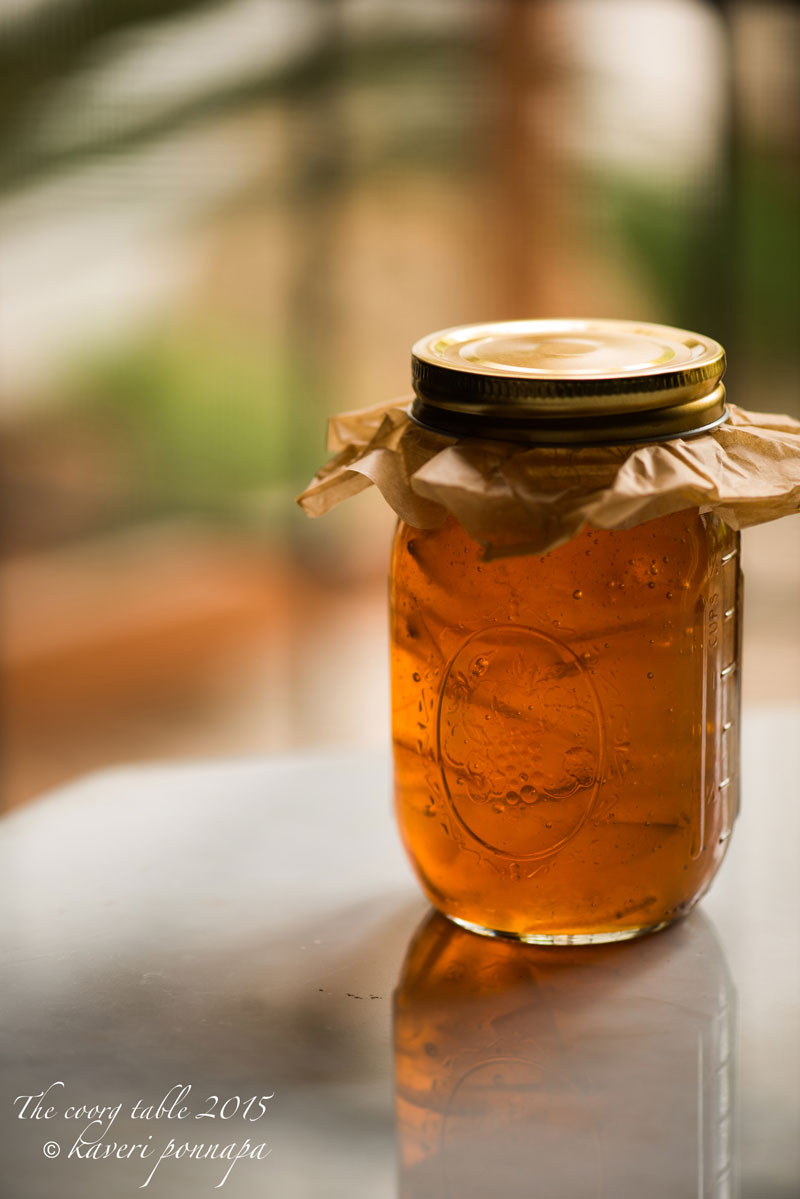
Bittersweet, with deeply flavoured shreds, when it is spread thickly on buttered toast, you don’t really want much more for a light breakfast. Of course, the breakfast never is all that light; the marmalade jar seems so tempting, you scoop up just another spoonful and then you need some toast to put it on…and so it goes. It is sticky, and has a mind of its own, spreading itself all over cutlery, plates and your hands. It rolls off slices of toast in golden blobs, and has to be scooped up and licked off fingertips. Just when you think it’s getting a little too sweet, you bite into a shred of rind that leaves a pleasing bitterness. The taste is clear, lingering and refreshing.
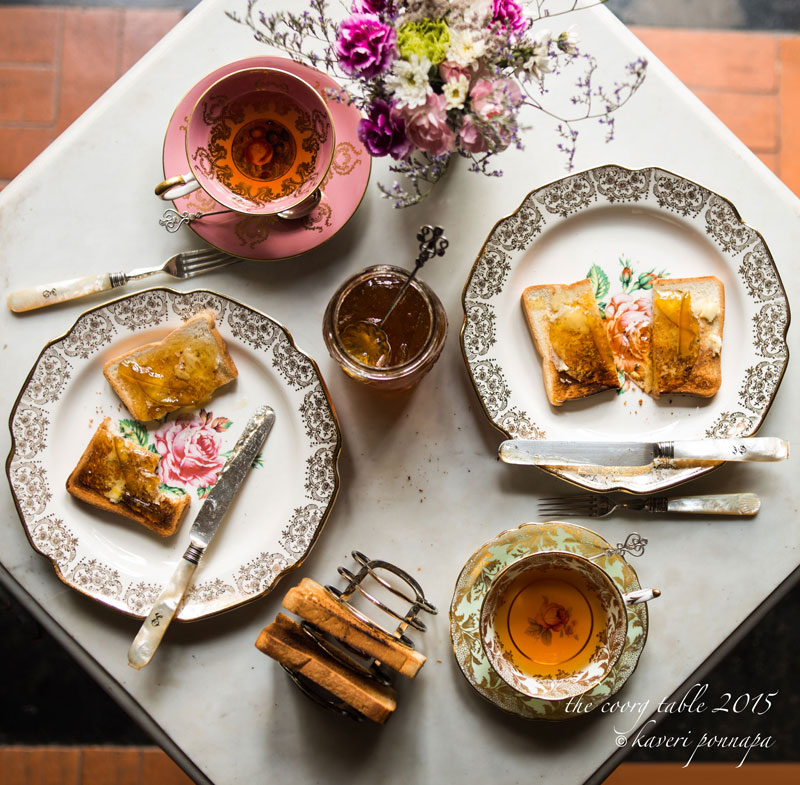 ne of the things that strikes now me is how little time we seem to have to enjoy small pleasures –like setting out pretty china and linen, maybe some heirloom cutlery, and spending time at the table. It doesn’t really take all that long, but it creates the perfect setting, and you experience a deep pleasure that stays for a long time after the meal has been consumed. I haven’t made any New Year resolutions at all, but maybe this could be one: to spend a bit of time every day at the table, in good company –any part of the day works fine –enjoying a quiet moment together. A breakfast for two on a verandah with a bottle of homemade bitter orange marmalade, and some time to savour life’s little moments seems like a very good way to start the year.
ne of the things that strikes now me is how little time we seem to have to enjoy small pleasures –like setting out pretty china and linen, maybe some heirloom cutlery, and spending time at the table. It doesn’t really take all that long, but it creates the perfect setting, and you experience a deep pleasure that stays for a long time after the meal has been consumed. I haven’t made any New Year resolutions at all, but maybe this could be one: to spend a bit of time every day at the table, in good company –any part of the day works fine –enjoying a quiet moment together. A breakfast for two on a verandah with a bottle of homemade bitter orange marmalade, and some time to savour life’s little moments seems like a very good way to start the year. 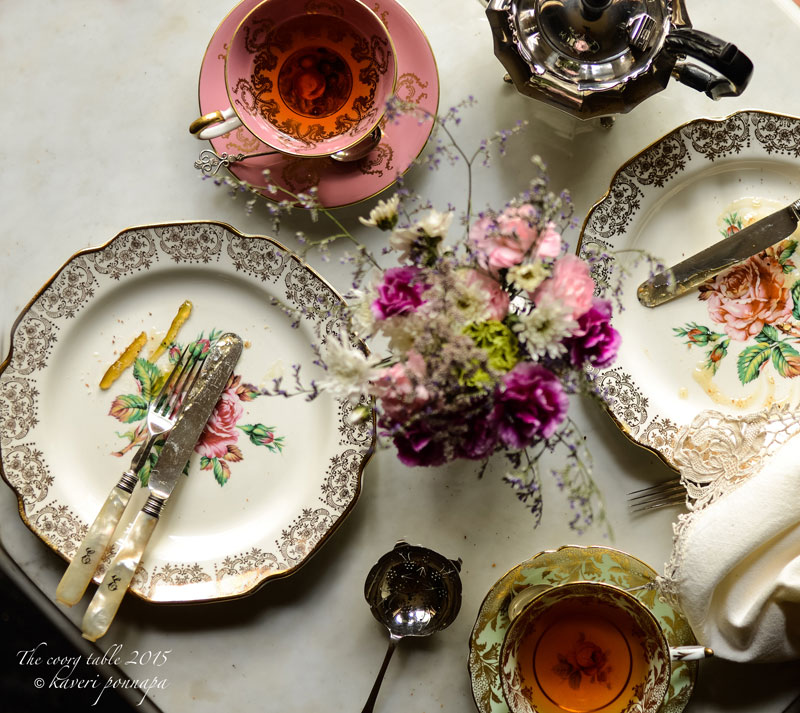
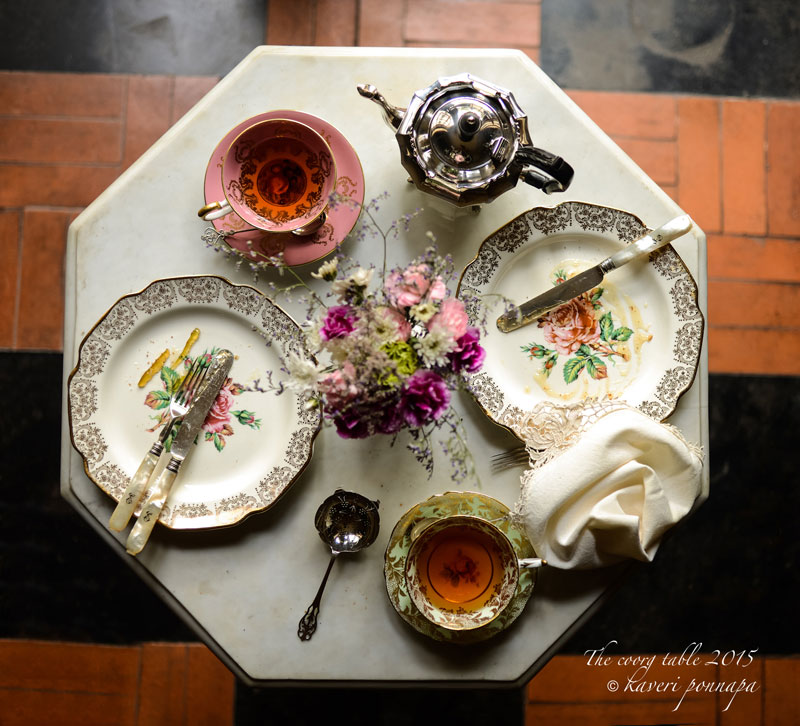
Image Credits: Nithin Sagi
All Food Styling: Kaveri Ponnapa
Thank you for visiting this page. If you read something that you enjoy, or see an image that you like, please take a moment to write a response. Do look out for the recipes of all the food featured here in my upcoming cookbook.

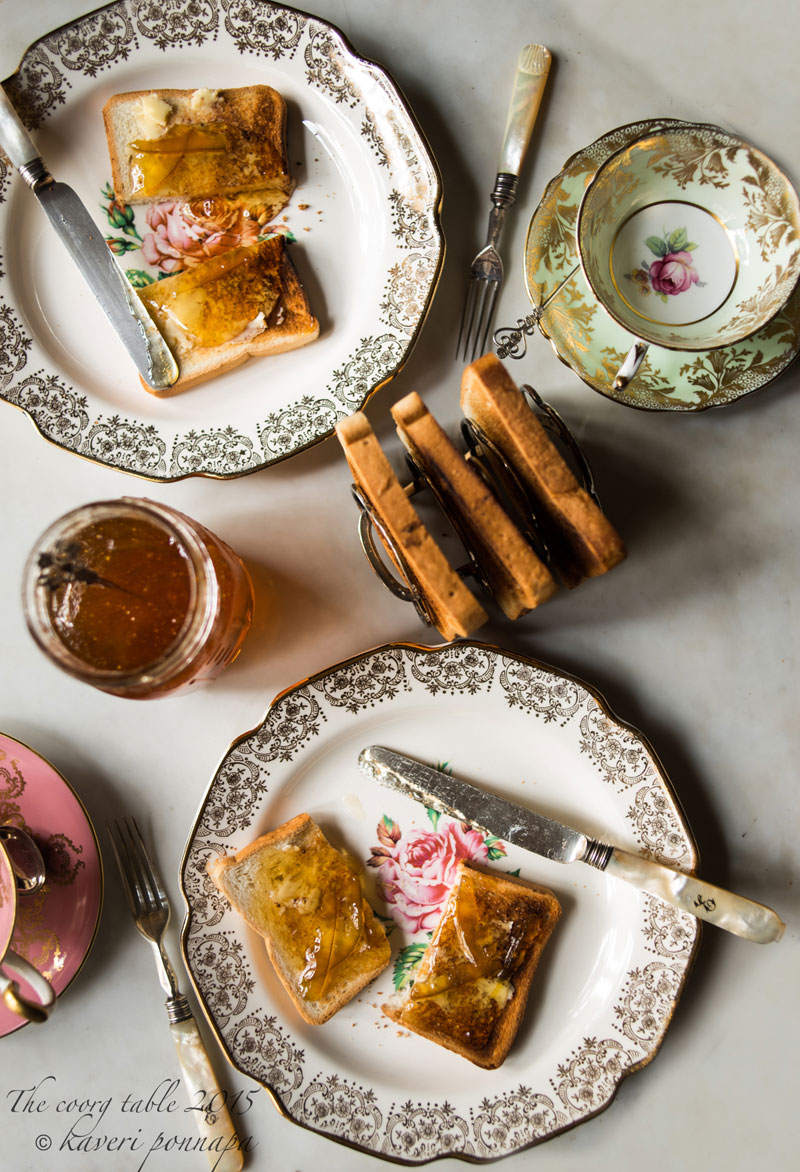



Hello Kaveri
Would it be possible for you to post a recipe of Guava marmalade. we find the fruit in abundance in Bangalore.
Regards
Anu
Hello Anu, thanks for your query – I do, actually have a very good recipe for guava jelly that I have been using for many years, that turns out absolutely delicious results . As you say, Bangalore has an abundance of guavas, and very good quality too, and it’s worth taking advantage of the glut. I will be posting the recipe sometime, although I can’t be very sure exactly when, since I will have to make a fresh batch,and photograph it too. Now that you have made the request, I will certainly push guava jelly higher up on the list! In the meanwhile, it would be nice to hear if you tried any of the other recipes, and how they turned out.Best wishes. Kaveri
Hii
Happy New Year!!
Thank you so much for sharing this. I love bitter-orange marmalade and people never wished to share the secret. 🙂
I am going to try this right away. Thanks again!!! Thelma
Hello Thelma, a very Happy New Year to you too, and I hope that you will have many jars of bitter orange marmalade on your table soon! 😉 Good food is meant for sharing, and I do feel that even if it is a treasured family recipe, sharing won’t do you any harm. My mother-in-law had a very successful run marketing her marmalade in Coorg for many years, and so many people wanted the recipe -of course, she could not really part with it then. But I think that even if she had, the marmalade would have tasted different – it is also the small matter of the hand makes it! Have some patience, marmalade is temperamental, but I am sure it will turn out beautifully. Good luck, and warm wishes. Kaveri
Hello, I never had this before. I will tell my mom to try this and let you know how it worked….Sounds yummy and delicious…Thanks!!!
And it is worth the effort, Kaverappa, because you can skip the toast, and eat it with akki ottis and fresh, home made Coorg butter! Absolutely delicious, I still do that, although I don’t get the home made butter here.Warm wishes. Kaveri.